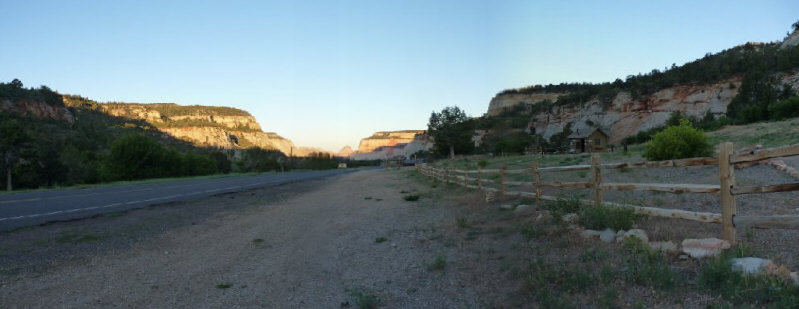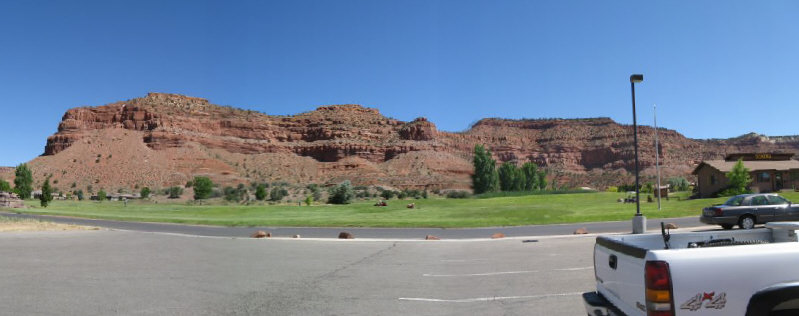|
AN AMATEUR GEOLOGY
ROAD TRIP
My travels through the Colorado Plateau of southern Utah and northern Arizona. by John Fuhring June, 2010 Page 1
Next morning I got up before dawn and put on some water for coffee.
Bringing along a tea pot for heating water was another really good
idea. I walked across the highway, took some pictures of Zion in the
early light and as soon as the roadside store opened, I paid them $10
for staying at their campground. Everything was put up and in the bed
of my truck and I started on the next leg of my journey.  Looking back along Highway 9 at Zion Park in the early morning. As mentioned, earlier plans to spend a day or two at Zion were canceled due to overcrowding and Plan 'B' called for seeing some things that I had been looking forward to for a long time. I really wanted to drive the long dirt road through a fantastic geologic structure called the Cockscomb. In addition, I had read a lot about the famous Kodachrome Basin with its unusual, very interesting, mysterious and highly controversial "sandstone pipes." It's a long way from Zion to Kodachrome Basin, and there's a lot of interesting places to stop at along the way, but if I got going, I could make it by the afternoon sometime.  Road map The first leg of day 2's trip was from my camp on Highway 9 east of Zion to Carmel Junction where I'd pick up Highway 89 (box 2). From there it's a short drive to the town of Kanab, Utah where I stopped at the BLM Visitor's Center to check on the condition of Cottonwood Road that takes you along the Cockscomb. They had some rain in the area earlier last week and the road is considered impassable in wet weather, so I wanted to make sure the road was open. Turned out that small amount or rain had only settled the dust and the road was in beautiful condition. Besides, with my high ground clearance, big tires and 4 wheel drive, I had nothing to worry about.  Kanab golf course and scenic formation from the BLM parking lot. By the way, I knew where they got the term "Grand Staircase" from, but I always wondered where the word "Escalante" came from. On or around the year 1776, same time as our Declaration of Independence, a priest named --- believe it or not --- Padre Escalante tried to find a route from the important government center of Santa Fe (Holy Faith), New Mexico to Monterey, Alta California. It seems that his expedition failed and he never made it out of what is today Utah, but with the help of friendly Native Americans, he was able to do his wanderings, take his notes and get back home alive to make an official report to the Governor of New Mexico. Some years later, with the information Escalante gained, a trail was opened to the community of Los Angeles in southern California called the Old Spanish Trail. Ironically, this trail, in part made possible by Father Escalante, opened this region up to the slave trade. I was really surprised to learn that the Native Americans of this region were subjected to kidnapping and being sold into slavery with all the inhumane cruelty that that implies. There is even a story that unsold slaves, especially children, would be killed by the slavers and that the early Mormons would buy them up to save them. I found that a little hard to believe, but I could well believe that greedy and cruel people would be engaged in slavery out here. I mean, after all, these greedy, cruel bastards weren't doing anything that wasn't going on a much larger and more horrific scale in more "civilized" places like South Carolina and Virginia. In fact, the slave trade ended in this region maybe 30 years before it was forcibly ended in our own Southern States. |